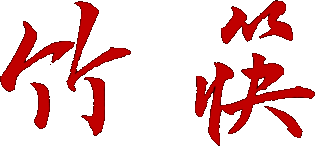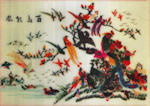Chopsticks Menus
Call (425) 776-1196 for take-out orders |  |
Reading Our MenuWelcome to Chopsticks! We have been in business for nearly 50 years, providing Edmonds and the surrounding community with fine Chinese cuisine in a comfortable and relaxed atmosphere. To help you gain a little better understanding of our menu, as well as some insights into the Chinese language, we have prepared this guide which we hope you will enjoy. | |||||||||||||||||||||||||
|
Like you will often see in many Chinese restaurants, we include Chinese listings on our menus for various dishes. These symbols often look unusual and confusing to people who are not familiar with them. While it would be impossible to teach you everything you might need to know to read Chinese, perhaps we can provide you with a little bit of insight to what you see listed on our menu. Let¡¯s start off with the two symbols which our customers have probably seen the most, which are those that are part of our logo: Öñ¿ê. As you might expect, these of course mean ¡°chopsticks¡±, specifically the two symbols stand for bamboo (Öñ) chopsticks (¿ê) and are pronounced ¡°zh¨² ku¨¤i¡±. Now that you¡¯ve had your first introduction to Chinese, let¡¯s work our way through the Dinner Menu. You¡¯ll notice that our menu is broken down into several different sections: | ||||||||||||||||||||||||
| |||||||||||||||||||||||||
|
Our menu starts off with the appetizer section. The two characters used are î^ (t¨®u) and Åè (p¨¦n) which which literally translate to head or leading, and basin. Chinese cuisine doesn't traditionally include an appetizer course, dishes which we might consider as appetizers are instead simply incorporated throughout the meal. You will however almost always find an appetizer section on menus at American Chinese restaurants since appetizers are such an established part of the common American dining experience. | ||||||||||||||||||||||||
|
If you look carefully, you will notice that many of these listings end with the same character, î or ¡°l¨¨i¡± which essentially means ¡°category¡±. So we will use this to separate the menu into its different sections. For the most part, the sections are broken down by the type of meat which goes into it. This brings us to another aspect of understanding a traditional Chinese menu. Unlike the menus at many restaurants which simply list one or two pages of selections, Chinese menus will often go on for pages and pages. You might think that this would make it difficult for the kitchen to cope with all of the dishes they are expected to produce. In fact, it¡¯s not that bad. Where a normal restaurant might list one dish, and then indicate that it can be made with ¡°chicken, beef, shrimp, or vegetarian¡±, a Chinese menu will list that same dish several different times, once under each category. | ||||||||||||||||||||||||
|
The first time we see this on the menu, is in reference to soups where we see it listed as «î. Since we know that ¡°î¡± means ¡°category¡± that must mean that ¡°«¡±, means ¡°soup¡±, which it does. When we combine the two together, it literally means ¡°types of soup¡±. There are essentially two types of soup in Chinese cuisine. ¡°Thin Soups¡± are cooked quickly, using a clear broth, with the meat and vegetables added at the very end to give them just enough cooking time. ¡°Thick Soups¡± on the other hand are all combined together at the beginning, and cooked slowly. A thickener, such as cornstarch, is then added near the end in order to give the soup its body. | ||||||||||||||||||||||||
|
The next category is for our pork dishes, and it is titled using the three characters: ¡°ØiÈâ. You should now be familiar with that last character, and it¡¯s meaning of ¡°Category¡±. This leaves us with two characters being used for ¡°pork¡±. It is the first character ¡°Øi¡± or ¡°zh¨±¡±, which actually means pork, or swine. The second character ¡°È⡱ or ¡°r¨°u¡± is used to indicate ¡°meat¡±. Specifically it essentially refers to meat which has been carved up by the butcher. |
| |||||||||||||||||||||||
|
And now we have our next category, for beef dishes titled ¡°Å£ Èâ . By now I shouldn¡¯t have to tell you what that last character means, and we just saw that the middle character means ¡°meat¡±, so all that remains is the first character ¡°Å£¡± or ¡°ni¨²¡±, which of course means ¡°beef¡±, or more specifically ¡°cow¡±, and when combined with the symbol for ¡°meat¡±, it means beef. It is interesting to note, that sometimes you will see the symbol for meat ¡°È⡱ all by itself, without any indication of what type of meat it is referring to. When you see this, it will always be referring to ¡°pork¡±. If you want to refer to beef or some other type of butchered meat, you have to specifically indicate that. | ||||||||||||||||||||||||
|
Next we have the listing for Poultry (ëuøî), which in addition to the character for ¡°type¡± we see two new characters, which together stand for ¡°poultry¡±. Well actually, the two characters have individual meanings. The first character ¡°ëu¡± or ¡°j¨©¡± stands for ¡°chicken¡± while the second character ¡°ø¡± or ¡°y¨¡¡± stands for ¡°duck¡±. By combining these two together it refers to ¡°poultry¡± in general. |
| |||||||||||||||||||||||
|
Next up, is the seafood section of our menu, labeled as ¡°º£õr. As with the poultry section, the two characters ¡°º£õr¡± or ¡°h¨£i xi¨¡n¡± have individual meaning, which when combined mean seafood. The first character ¡°º£¡± or ¡°h¨£i¡± means ¡°fresh¡±, while the second character ¡°õr¡± or ¡°xi¨¡n¡± means ¡°from the sea¡±. So combined they mean ¡°fresh from the sea¡±, or ¡°seafood¡±. Cantonese cuisine comes mostly from the Guangdong province in China, which is located in the southeast corner of China, essentially the equivalent of Florida in the US. As you might expect, there is a wealth of seafood available, and it is a specialty of the region. | ||||||||||||||||||||||||
|
Our vegetable section is labeled with ¡°Êß²Ë, where again we have two characters ¡°Ê߲ˡ± or ¡°sh¨± c¨¤i¡± being used to represent this particular category. Together they mean ¡°vegetable dishes¡±. Individually, ¡°Êß¡± or ¡°sh¨±¡± means simply vegetables, while ¡°²Ë¡± or ¡°c¨¤i¡± means of course ¡°dish¡±, but specifically it stands for a food dish of vegetables. While we previously said that Chinese menus are organized by the main ingredient being used, and not by the type of dish itself, we are now entering a part of the menu where we reverse that trend. There are several Chinese dishes that customers are so familiar with, that they want them to be easy to find on the menu. So for Egg Foo Young, Fried Rice, Chow Mein, and Chop Suey, we list those individually, and then simply indicate that you can then select the main ingredient you want to add to it. | ||||||||||||||||||||||||
|
Egg Foo Young is a very popular dish that is found in most Chinese restaurnts across America. While many might believe that this dish was created in America by Chinese immigrants, it in fact is based on an authentic Chinese dish, and its name is derived from the ¡°Fu Yong¡± flower, which is a type of hibiscus flower. The name of this dish can be represented just with the first two characters ¡°Ü½ÈØ¡± or ¡°f¨² r¨®ng¡±, with the last character ¡°µ°¡± or ¡°d¨¤n¡± just generically referring to eggs, or being oval shaped. | ||||||||||||||||||||||||
|
Rice is of course a major staple of the Chinese diet, and is as common in Chinese restaurants as pasta is in an Italian restaurant. Yes, the English listing in our menu says ¡°Fried Rice¡± but the character ¡°ï¡± or ¡°f¨¤n¡± really means just ¡°rice¡±. Well, not ¡°just¡± rice. Since rice is so important to the Chinese diet, this character also represents food, a meal, or cuisine in general. In our next section, we are actually combining three different related dishes together under a single category listing. | ||||||||||||||||||||||||
|
Chow Mein ¡°³´üI¡± is a rather generic term used to refer to a dish of stir-fried noodles, with many variations on what it consists of beyond that. Normally it will contain some type of meat, along with a variety of vegetables, quickly stir-fried with soft noodles and a fragrant sauce. There are several different specific ways which chow mein might be prepared. Traditionally the softened/boiled noodles are quickly pan-fried in a wok before being combined with the other ingredients. You can also make what is commonly referred to as ¡°lo mein¡±, in which the noodles are simply cooked in water like pasta and not fried at all before combining with the other ingredients. You can also use crispy noodles instead of soft, and simply cover them with the other ingredients. | ||||||||||||||||||||||||
|
You may notice that the listing for Chow Mein includes a total of four characters, and we¡¯ve only dealt with two so far. The other two characters ¡°«üI¡± should now look familiar to you. Notice that the second character is the same as we just saw in chow mein, and so it of course stands for ¡°noodles¡±. The first character we saw earlier being used for ¡°soup¡±, and so as you might expect, this stands for ¡°soup with noodles¡±. It is essentially the same thing as our normal chow mein preparation, except we have also added a nice broth to it, and serve it in a large bowl. | ||||||||||||||||||||||||
|
Chop Suey is another one of those dishes which is found in almost all Chinese restaurants across America. The individual characters for chop suey are ¡°ës¡± or ¡°z¨¢¡± which translates to ¡°mixed; blended; mingle¡±, and the second character ¡°Ë顱 or ¡°su¨¬¡± translates to ¡°break; smash; broken¡±. So ¡°Chop Suey¡± essentially translates to ¡°all chopped up and mixed together¡±. Chop Suey is fairly similar to Chow Mein, in that it is a stir-fry of meat and vegetables, in a sauce. But where Chow Mein includes noodles, Chop Suey is instead served over rice. It is commonly said that Chop Suey was invented in America by Chinese Immigrants as a way to make use of leftovers. However there is evidence that it is an actual Chinese dish from Tsaishan, a district of the Guangdong Province, with reports of its existence dating back to the 1890¡¯s. It would make its first appearance in America in 1898 where it was described as ¡°A Hash of Pork, with Celery, Onions, Bean Sprouts, etc.¡± | ||||||||||||||||||||||||
|
The final section on our menu ¡°ÌðÆ·¡± or ¡°ti¨¢n p¨«n¡± is for desserts. The First character ¡°Ì𡱠or ¡°ti¨¢n¡± translates to "sweet", while the second character ¡°Æ·¡± or ¡°p¨«n¡± translates to ¡°products; goods¡±, so combined as we see them here, they mean ¡°sweet products¡±. American meals will traditionally have a dessert course with dishes such as pies, cakes, and various other selections which are typically intended to eat on their own. In China, what would be considered as a dessert or sweet offering, are typically smaller options which are intended to be accompanied by tea at the very end of the meal. | ||||||||||||||||||||||||


